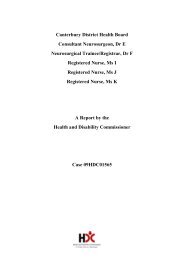Gisborne Hospital Report - Health and Disability Commissioner
Gisborne Hospital Report - Health and Disability Commissioner
Gisborne Hospital Report - Health and Disability Commissioner
You also want an ePaper? Increase the reach of your titles
YUMPU automatically turns print PDFs into web optimized ePapers that Google loves.
<strong>Gisborne</strong> <strong>Hospital</strong> 1999 – 2000<br />
Operating Theatre Protocols<br />
possibility of blood contamination in general. Sometimes this concern<br />
seemed to affect her overall performance. This has some bearing on<br />
intravenous inductions because I note that one incident report listed<br />
danger to the assistant as being a criticism of intravenous inductions in<br />
children. I have never heard of that being a consideration either before<br />
or after being in <strong>Gisborne</strong>. Again, it is my opinion that, if it is hospital<br />
policy for the nurses <strong>and</strong> technicians to critique the choice of procedures<br />
done by senior medical staff, then that was not at all well brought [out]<br />
in my orientation. I do not do intravenous inductions in children<br />
because I believe they are as good as or as safe as inhalation inductions;<br />
I do them because I believe they are superior to <strong>and</strong> safer than<br />
inhalational inductions. This is not a criticism of anaesthetists who do<br />
inhalational inductions; it is the prerogative of each consultant to choose<br />
what is safest in his or her own h<strong>and</strong>s. I don’t believe the Nurses or the<br />
Administration grasps the subtlety of this point.”<br />
Staff comments on Dr Lucas’ method of child induction<br />
9.7 A surgeon commented that although Dr Lucas was said to be insensitive <strong>and</strong><br />
uncaring in the way he induced children, the locum who replaced Dr Lucas<br />
induced children the same way, yet was not subject to complaints about his<br />
methods of induction.<br />
9.8 The acting Medical Director noted that in the interviews he conducted with<br />
staff about the syringe incident one staff member was concerned at the way a<br />
child was put under anaesthetic by Dr Lucas. Another senior anaesthetic<br />
technician thought he was “great” at working with child patients.<br />
9.9 One anaesthetic technician considered the intubations in the rapid sequence<br />
discussed above involved a safety issue, but at the end of the day Dr Lucas<br />
“carries the can”, so he can do procedures the way he wants. He did not talk<br />
to Dr Lucas about his concerns in relation to this incident because of the need<br />
to get the procedure done. After this incident the anaesthetic technician tried<br />
to avoid working with Dr Lucas whenever he could. This did not need<br />
explaining as everybody else was doing the same thing by trying to avoid Dr<br />
Lucas’ list. “Those who came to work earliest in the morning could choose<br />
the list they did.”<br />
Management response<br />
9.10 The Group Manager (<strong>Hospital</strong>) stated that the practice at <strong>Gisborne</strong> <strong>Hospital</strong> for<br />
anaesthetising children is gas induction. The matter was discussed at a theatre<br />
management committee meeting. The Group Manager (<strong>Hospital</strong>) wrote to the<br />
anaesthetists collectively <strong>and</strong> he copied this correspondence to the Theatre<br />
Manager.<br />
111
















